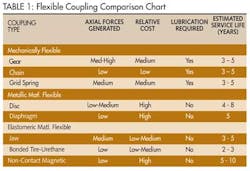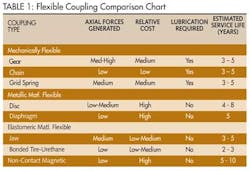Back to Basics- Pump Coupling Selection
By Allan Budris
Selecting the best coupling type for an application can have a positive impact on pump, driver, and/or coupling reliability and maintenance costs. Radial and/or axial loads that are transmitted to the pump and/or motor bearings (through the coupling) will reduce the life of these bearings. Further, any transmitted vibration will also short the life of the pump mechanical seal.
The primary function of a coupling is to transmit rotary motion and torque from one piece of equipment to another. Couplings may also perform other (secondary) functions, such as accommodating misalignment between shafts, transmitting (or not transmitting) axial thrust loads and vibration from one machine to another, permitting axial adjustment of the shafts to compensate for machinery wear, and maintaining precise alignment between connected shafts.
Another secondary function provided on many pump couplings is a separate "spacer" section that allows the driver and driven shaft ends to be positioned a specified distance apart. The coupling spacer on horizontal pumps can then be removed to allow sufficient axial clearance to replace a mechanical seal without moving the pump or motor, or to allow room for the pump "back-pull-out" element to be replaced without moving the motor. Also, since allowable shaft misalignment is normally expressed in fractions of an angle (in degrees) a longer spacer will accommodate more parallel shaft offset than a shorter spacer or couplings without spacers. Most couplings can be provided in spacer or non-spacer configurations.
Couplings can be divided into two primary groups, rigid and flexible. Rigid couplings are used to connect machinery shafts, where it is desirable to maintain the shafts in precise alignment, transmit torque and axial thrust (if desired). Rigid couplings are common on vertical turbine pumps as well as some short set pumps. Flexible couplings accomplish the primary function of any coupling, transmitting the driving torque between the driver and driven machine. In addition, they perform a secondary function of accommodating a set amount of misalignment between the driving and driven shafts. Most horizontal, baseplate mounted (long-coupled) pumps use flexible couplings.
The following technical information is normally required when selecting a coupling:
- Horsepower to be transmitted
- Operating speed
- Angular Misalignment
- Offset misalignment
- Axial travel
- Limitation on coupling generated forces
- Ambient temperature
- Space limitations
Rigid Couplings
Rigid couplings are found in certain short set, vertical-in-line, and vertical turbine pumps applications. Since these couplings do not compensate for any misalignment between the pump and motor shaft ends, failure to ensure precise alignment of the connecting shafts will result in increased vibration, bearing wear, and shortened mechanical seal life.
Flexible Couplings
Flexible couplings, which are used for most horizontal pump applications, may be separated into three basic types, mechanically flexible, material-flexible, and non-contact magnetic. Mechanically flexible couplings compensate for misalignment between two connected shafts by means of clearances incorporated in the design of the coupling. Material-flexible couplings rely on flexing of the coupling element to compensate for shaft misalignment. Modern non-contact magnetic couplings rely on rare earth permanent magnets which induce current flow in the mating electro magnets. They are separated by an air gap.
Mechanically Flexible Couplings
Mechanically flexible couplings compensate for misalignment between the connected shafts by means of clearances incorporated in the design of the coupling. Gear couplings are probably the most frequently used mechanically flexible coupling configuration. They are "power-dense", meaning that they are capable of transmitting high torque at high speeds in a compact size. Axial force and moment transmission can be quite significant with gear couplings. The axial force must be absorbed by the thrust bearings in the driver and driven machines. Also, these couplings must be periodically lubricated with coupling specific grease, which adds to the maintenance cost. Further, the gear teeth are prone to wear over time.
Material-Flexible Couplings
These couplings rely on flexing of one or more coupling elements to compensate for shaft misalignment. The flexing element may be of any suitable material (metal, elastomer, or plastic), which has sufficient resistance to fatigue failure to provide acceptable life. Material-flexible couplings do not require periodic lubrication, but the flexing action can generate excessive heat (a potential problem with elastomer or plastic couplings), and/or can cause fatigue (a potential problem with metals), if loads or misalignment exceed defined limits. This will shorten the life of these couplings.
The advantages of material-flexible, non-lubricated couplings (over mechanically-flexible couplings) are:
- 1. No down time for lubrication.
- 2. Generally transmit low, known thrust forces.
- 3. They can be designed for infinite life.
- 4. Except for the rubber tire-type couplings, maintaining balance is easier than for gear couplings.
Metallic Flexible Material Couplings
Metal-disc (or disc-pack) couplings are the predominant type used in process plants throughout the industrialized world. They use thin, contoured, high-strength alloy steel laminated sheet-metal discs alternately bolted to the driving and driven hub members. There are numerous configuration variations of this coupling. Properly selected and installed, disc pack couplings with captured center members are generally the most cost-effective choice.
Another example of an all-metal material-flexible coupling is the contoured diaphragm coupling. This coupling is similar in function to the metal-disc coupling in that the single or twin disc assemblies flex to accommodate misalignment. They are primarily used for large pumps.
Metallic flexible material couplings have the following advantages:
- No downtime for lubrication
- Transmit low, known, thrust forces
- Can be designed for infinite life
- Better balance can be maintained
- Torsionally Stiff
- Good high temperature capability
- High torque
- High speed
- Zero backlash
Metallic flexible material coupling limitations:
- Fatigue potential when misalignment exceeds coupling limits
- Most need careful alignment
- Usually cannot damp vibration
Elastomer Material Flexible Couplings
Material-flexible couplings employing elastomeric materials are numerous. Elastomers generally do not have a well-defined fatigue limit. However, most elastomers do suffer some form of degradation from heat and require de-rating at elevated temperatures. Heat develops in the material when the coupling flexes, and claims that they will operate at severe misalignments are often very misleading. Anything other than moderate misalignment will severely limit coupling life.
Elastomeric flexible material couplings advantages are as follows:
- Generally do not have defined fatigue limits
- Torsionally soft / good vibration damping
- No lubrication or maintenance
- Less expensive than metallic couplings
- Lower reactionary loads on bearings
- More misalignment allowed than metallic types
Elastomeric flexible material coupling limitations:
- Sensitive to chemicals / high temperatures
- Larger outside diameters than metallic couplings
- Difficult to balance as an assembly
- Some types have low overload torque capacity
Magnetic Couplings
The same basic coupling used for the "Adjustable Speed Permanent Magnet Drives" spelled out in last month's Pump Tips Column, can also be used in a simplified version as a constant speed pump coupling, with some distinct advantages. The biggest advantage is that the air gap allows the coupling to tolerate the highest shaft misalignment of any coupling type, to the point that laser alignment of the pump and motor shaft is not necessary. Also, it will not transmit vibration and/or forces between the pump and motor. This can increase bearing and mechanical seal life in pumps and bearing life in motors.
Advantages of magnetic couplings:
- Low maintenance, does not require periodic lubrication
- Tolerates gross parallel and angular misalignment.
- Eliminates vibration transfer between motor and pump
- Increases seal life
- Permits shock loading
- Overload torque protection, self-resetting
- Cushioned starts and stops
Limitations of magnetic couplings:
- High initial cost
- Couplings will experience a 1% - 3% slip (slight speed reduction)
- Heat sensitive:
- – Induction current adds heat to driven portion of coupling
- – Excessive heat can weaken permanent magnet strength.
REFERENCES:
1. "Pump User's Handbook – Life Extension", third edition, 2010, by Heinz P. Bloch & Allan R. Budris, Published by The Fairmont Press, Inc.
About the Author: Allan R. Budris, P.E., is an independent consulting engineer who specializes in training, failure analysis, troubleshooting, reliability, efficiency audits and litigation support on pumps and pumping systems. With offices in Washington, NJ, he can be contacted via e-mail at [email protected].

